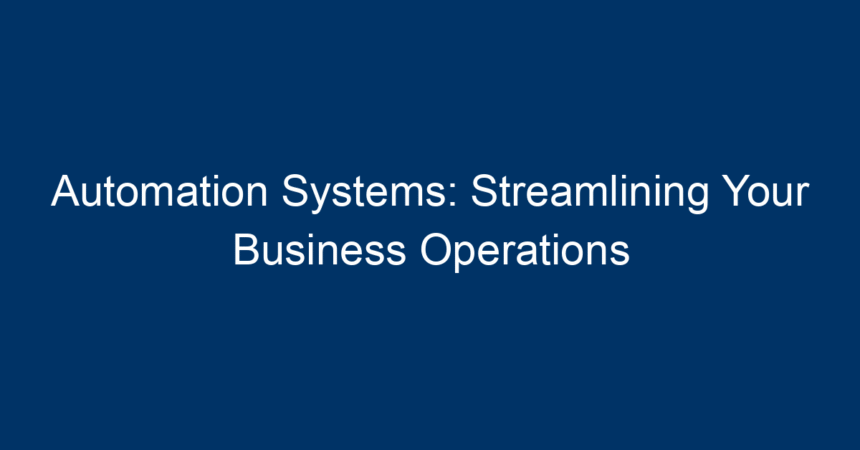In today’s fast-paced business environment, efficiency is not just a goal; it’s a necessity. Companies are constantly searching for innovative solutions to optimize their processes, reduce costs, and enhance productivity. One of the most effective strategies to achieve this is through the implementation of automation systems. These sophisticated solutions allow businesses to streamline operations, minimize human error, and focus on what truly matters—growth and customer satisfaction. In this article, we’ll dive deep into the world of automation systems, exploring their benefits, types, and real-world applications.
What Are Automation Systems?
Automation systems refer to technologies and processes that either partially or fully automate tasks and operations within an organization. These systems can range from simple tools that automate routine tasks to complex integrated platforms managing various functions like manufacturing, customer service, and data management.
Types of Automation Systems
Understanding the different types of automation systems can help businesses choose the right tools for their specific needs. Here are the primary categories:
1. Industrial Automation
Primarily used in manufacturing, industrial automation systems employ machinery, control systems, and sensors to optimize production processes. Common applications include robotic assembly lines, conveyor systems, and quality control processes.
2. Office Automation
Office automation helps streamline administrative tasks like document management, information sharing, and communication. Tools such as email automation, scheduling software, and customer relationship management (CRM) systems fall into this category.
3. Home Automation
Though often overlooked in a business context, home automation technologies can enhance the productivity of remote teams. Smart devices facilitate energy management and security, allowing for optimized work environments.
4. IT Process Automation
This category focuses on automating backend IT operations, ensuring that software and hardware systems run smoothly without manual intervention. Activities like data backup, software updates, and system monitoring are typical of IT automation.
Benefits of Automation Systems
The integration of automation systems into business operations offers numerous advantages, including:
1. Increased Efficiency
By automating repetitive tasks, employees can focus on high-value activities. For instance, automation systems can handle processes like data entry and report generation, freeing up time for strategic thinking and innovation.
2. Cost Reduction
While the initial investment in automation systems may seem substantial, the long-term savings can be significant. Reduced labor costs, decreased time spent on tasks, and lower error rates all contribute to a healthier bottom line.
3. Enhanced Accuracy
Human error is unavoidable, especially during monotonous tasks. Automation systems minimize these mistakes, ensuring that outcomes are predictable, reliable, and consistent, which is crucial for maintaining quality standards.
4. Improved Data Management
Automation systems enable effective data collection and analysis, allowing businesses to make data-driven decisions. For example, CRM systems can help track customer interactions and analyze buying patterns, leading to better marketing strategies.
5. Scalability
As businesses grow, so do their operational demands. Automation systems can quickly scale to accommodate increased workload without necessitating proportionate increases in staff or resources.
Implementing Automation Systems in Your Business
The successful implementation of automation systems doesn’t happen overnight. Here are actionable steps to consider:
1. Identify Pain Points
Start by assessing your current operations. Identify repetitive tasks that consume significant time and resources. This could range from customer inquiries to inventory management.
2. Set Clear Objectives
Define what you want to achieve with automation. Is it reducing operational costs, improving service delivery, or enhancing data accuracy? Clear objectives guide the entire automation strategy.
3. Choose the Right Tools
Research and select automation systems that align with your identified pain points and objectives. Factors to consider include ease of integration, user-friendliness, and scalability.
4. Train Your Team
Introducing new technologies requires buy-in from your staff. Offer comprehensive training and resources to help employees understand how to effectively use the automation systems.
5. Monitor and Optimize
Once implemented, continually assess the performance of your automation systems. Gather feedback from users to identify areas for improvement and ensure that the systems are meeting your objectives.
Real-World Applications of Automation Systems
To illustrate the impact of automation systems, let’s look at a few industries that benefit significantly from their deployment:
1. Manufacturing
In manufacturing, businesses utilize automation systems for tasks like assembly, material handling, and quality inspection. For instance, automotive companies use robotics to speed up production while maintaining high-quality standards, significantly reducing time-to-market.
2. Retail
Retailers have increasingly adopted automation systems, particularly during the pandemic. E-commerce platforms use chatbots for customer service, automated inventory management systems to track stock levels, and predictive analysis to tailor marketing campaigns.
3. Healthcare
In the healthcare sector, automation systems streamline patient management and administrative tasks. Hospitals use electronic health records (EHR) to automate patient data collection and appointment scheduling, improving patient care efficiency.
4. Finance
The financial industry leverages automation for tasks like data analysis, transaction processing, and risk assessment. Automated systems can quickly analyze large volumes of data, providing timely insights for decision-making.
Future Trends in Automation Systems
As technology continues to evolve, so too will automation systems. Here are a few trends that are likely to shape the future:
1. Artificial Intelligence and Machine Learning
AI and machine learning will enhance the capabilities of automation systems, allowing for predictive analysis and smarter decision-making processes. These systems will become more adaptive, learning from historical data to improve accuracy.
2. Robotic Process Automation (RPA)
RPA will become increasingly sophisticated, enabling businesses to automate complex workflows and integrate seamlessly with existing systems. This trend will help businesses further reduce the need for manual intervention.
3. Cloud-Based Solutions
Cloud technology will allow for greater accessibility and collaboration. Businesses will increasingly adopt cloud-based automation systems for their flexibility and scalability, making it easier to manage operations in real time.
4. Focus on Security
As automation becomes more prevalent, security will be a primary concern. Future automation systems will likely incorporate robust security measures to protect sensitive data, especially in environments like finance and healthcare.
Conclusion: Taking the Leap into Automation
Implementing automation systems is not just about tech upgrades; it’s about fundamental changes in how a business operates. The potential benefits—ranging from increased efficiency and cost savings to enhanced data management—make it an attractive option for businesses of all sizes.
Actionable steps such as identifying pain points, setting clear objectives, and training teams are essential for a successful transition to an automated environment. As technology continues to advance, the future of automation systems promises even greater efficiencies and innovations.
Don’t just keep up with the competition; leverage automation systems to get ahead and deliver exceptional value to your customers. Embracing this change today will position your business for the challenges and opportunities of tomorrow.




